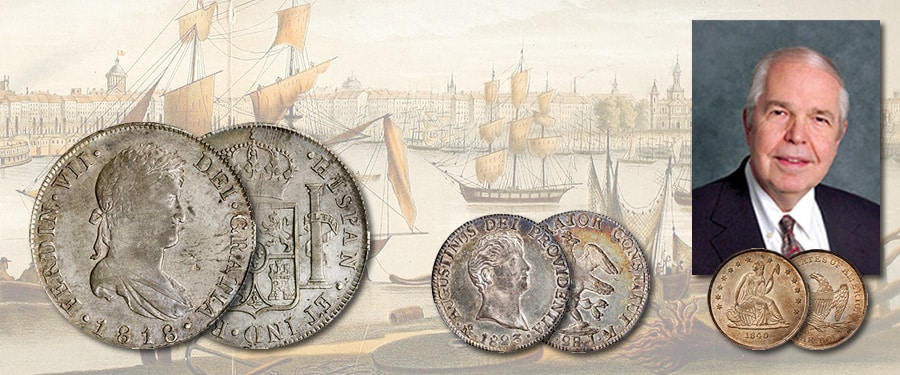
By Q. David Bowers – Co-Founder, Stack’s Bowers …..
On October 29, 1982, a few minutes past noon, pandemonium prevailed in the French Quarter in downtown New Orleans as earthmoving equipment brought to light a vast treasure of silver coins. The site, scheduled to be used for a new Meridien Hotel, may have secreted a long-forgotten bank reserve.
Passersby grabbed what they could in a frantic free-for-all. In the melee, no accounting was ever made of what was found.
However, it is estimated that over 1,000 (perhaps well over) silver pieces were found including large numbers of Spanish-American silver coins. Apparently, these had been buried in three cedar boxes. A report of the scramble by James H. Cohen noted:
“Visualize, if you will, businessmen in Brooks Brothers suits, women executives dressed in high heels and stockings, and laborers in their work clothes all on their hands and knees in mud, at times up to their waists, digging with their bare hands for buried treasure.”
Among large-denomination United States silver coins, various half dollars from about 1811 to 1837 were registered, as was a solitary 1798 dollar. However, most attention by numismatists was centered on a remarkable cache of Liberty Seated quarter dollars struck at the nearby New Orleans Mint in 1840 and 1841, many of which were Mint State! A few of the 25-cent pieces were of the 1840-O No Drapery variety, but most were 1841-O With Drapery. The exact quantity of 1840-O and 1841-O quarters found has been a matter of conjecture ever since. Larry Briggs, in The Comprehensive Encyclopedia of United States Seated Quarters, notes that of one die variety of 1841-O alone, more than 200 coins are known from this hoard.
The latest-dated coin in the New Orleans hoard was an 1842 quarter dollar, which dealer James H. Cohen graded as “About Uncirculated, which indicates that the hoard was buried shortly thereafter.”
Additional information on this fascinating find is revealed in the following personal interview notes by James D. Ash, taken with New Orleans coin dealers and collectors and an investment broker who was on the scene:
“The coins were found in three cypress [sic] boxes. The first was broken open, and the coins were mingled with mud and dirt and many passersby entered the excavation area to gather these coins… The second box was picked up at the scene by two individuals and loaded into a pickup truck. They left the scene quickly without opening the box at the time. So far as is known, the contents of this box never came on the local coin market. The third box was more systematically distributed at the scene, and numerous specimens from it were traded and sold to the local market… The coins were 80% foreign and 20% United States. Most of the foreign pieces were Spanish-American silver 2-real and 8-real pieces. The United States coins were all quarters plus a few higher denominations.”
The typical coin was blackened from 150 years of immersion in damp soil. Many were cleaned soon thereafter, judiciously or otherwise, by numismatists. Today survivors from this hoard can be identified by having a somewhat matte-like surface (not lustrous mint frost), usually with some traces of gray or black in areas.




